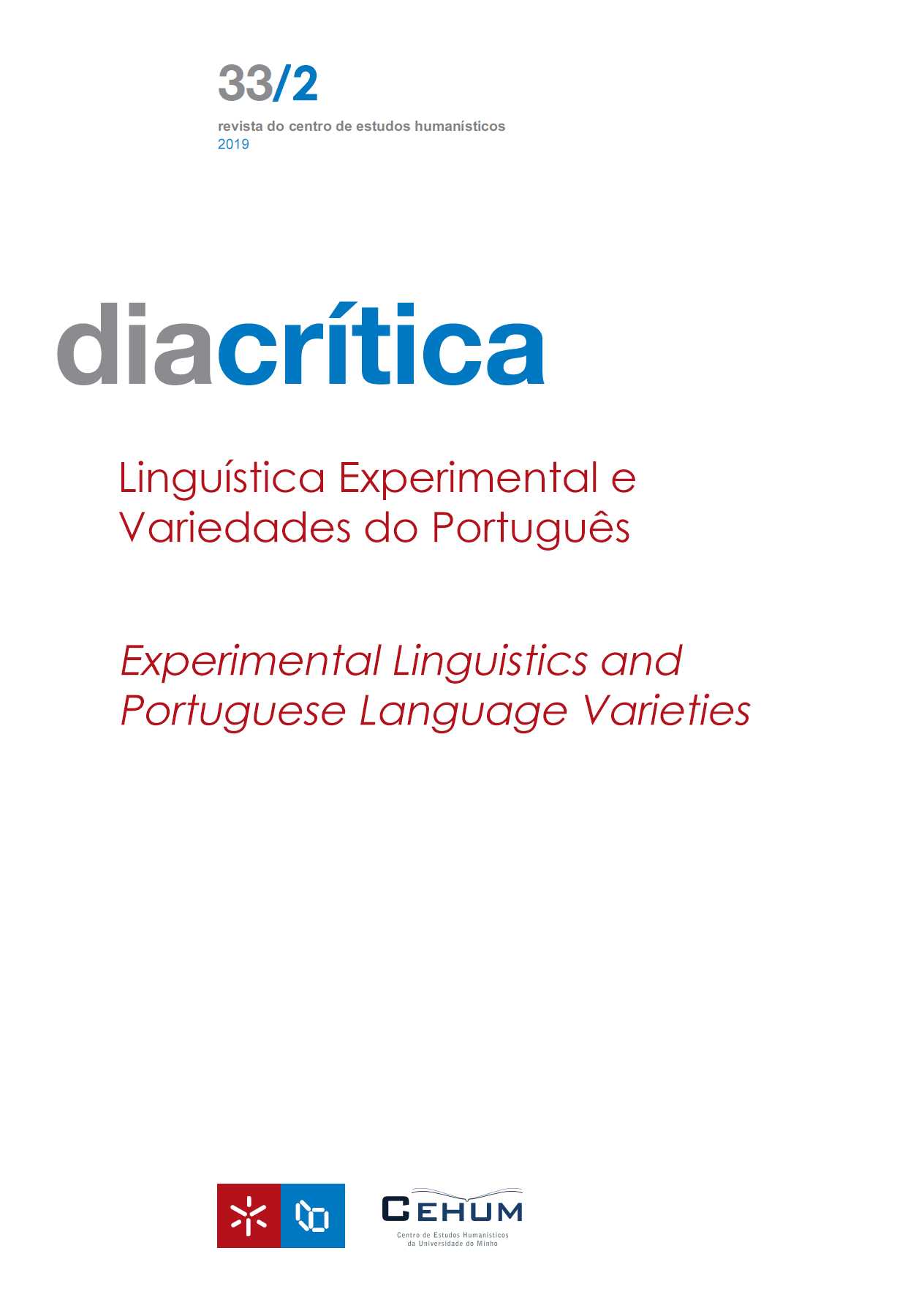Reverse transfer in clitic collocation a study on spanish and brazilian portuguese
DOI:
https://doi.org/10.21814/diacritica.5058Keywords:
Clitic placement, Reverse transfer, Portuguese, SpanishAbstract
This study focuses on reverse transfer, that is, the influence of L2 on L1, in a dominance situation of L1. It investigates clitic collocation in verbal complexes in Brazilian Portuguese (BP) and Spanish. Spanish privileges proclisis to the auxiliary verb (pre-verbalposition/clitic climbing) orenclisis to the main verb (post-verbalposition). BP, in turn, lost clitic climbing in the XIX century. Although schooling tries to recover it, natural speech privileges proclisis to the main verb (medial position). Thus, in principle, it can be assumed that highly educated BP speakers may accept clitic climbing, regardless of any fluency in Spanish. On the other hand, full acceptance of clitic climbing may constitute a case of reverse transfer in the context of bilingual BP/high-proficiency Spanish speakers. In order to observe this situation, a self-paced reading experimental task with a Likert scale grammatical judgment was applied, manipulating the position of the clitic in Portuguese sentences with highly educated BP monolinguals and BP/high-proficiency Spanish bilinguals. The results show that both groups accept clitic climbing, but bilinguals accept it even more, and are faster in reading Portuguese sentences with clitic climbing, suggesting a possible Spanish facilitation in the Portuguese sentence processing.
References
Chomsky, N. (1981).Lectures on Government and Binding. Dordrecht, Netherlands: Foris.
Cook, V. (1991). The poverty-of-the-stimulus argumentandmulticompetence.Interlanguage Studies Bulletin (Utrecht),7(2), 103–117. https://doi.org/10.1177/026765839100700203 DOI: https://doi.org/10.1177/026765839100700203
Cook, V. (2003). Effects of the Second Language on the First. Clevedon: Multilingual Matters. DOI: https://doi.org/10.21832/9781853596346
Duarte, M. E. L. (2000). The loss of the Avoid Pronoun principle in Brazilian Portuguese. In M.A.Kato&E.V.Negrão(Eds.),Brazilian Portuguese and the null subject parameter(pp. 17–36). Frankfurt: Vervuert-Iberoamericana. DOI: https://doi.org/10.31819/9783964561497-002
Gonçalves, A. & Leitão, M. (2011). O processamento de orações relativas com e sem o pronome “that” por brasileiros aprendizes tardios de inglês como L2. Organon,51, 129–144.https://doi.org/10.22456/2238-8915.28837 DOI: https://doi.org/10.22456/2238-8915.28837
González, N. T. (1994). Cadê o pronome? O gato comeu: Os pronomes pessoais na aquisição/aprendizagem do espanhol por brasileiros adultos(Unpublished Doctoral thesis, São Paulo University, São Paulo, Brasil).
Holmberg, A., Nayudu, A. & Sheehan, M. (2009). Three partial null subject languages: Acomparison of Brazilian Portuguese, Finnish and Marathi. StudiaLinguistica, 63(1), 59–97.htps://doi.org/10.1111/j.1467-9582.2008.01154.x DOI: https://doi.org/10.1111/j.1467-9582.2008.01154.x
Jarvis, S. (2003). Probing the effects of the L2 on the L1: a case study. In V. Cook (Ed.),Effects of the second language on the first(pp. 81–102). Clevedon: Multilingual Matters. DOI: https://doi.org/10.21832/9781853596346-007
Kayne, R. (1989). Null subjects and clitic climbing. In O. Jaeggli & K. Safir (Eds.),The null subject parameter (pp. 239–261). Dordrecht: Reidel. DOI: https://doi.org/10.1007/978-94-009-2540-3_8
Kato, M. A. (2000). The partial pro-drop nature and the restricted vsorder in Brazilian Portuguese. In M.A. Kato & E.V. Negrão (Eds.),Brazilian Portuguese and the null subject parameter(pp. 223–258).Frankfurt: Vervuert-Iberoamericana. DOI: https://doi.org/10.31819/9783964561497-011
Kato, M. A. (2005). A gramática do Letrado: questões para a teoria gramatical. In M. A. Marques, E. Koller,J.Teixeira & A. Lemos (Eds.),Ciências da Linguagem: Trintaanos de investigação e ensino(pp.131–145). Braga: CEHUM.
Kato, M. A. & Duarte M. E. L. (2014). Restrições na distribuição de sujeitos nulos no Português Brasileiro. VEREDAS, 18(1), 1–22.
Kecskes, I.& Papp, T. (2003). How to Demonstrate the Conceptual Effect of the L2 on L1?.In V. Cook (Ed.),The Effect of L2 on L1(pp. 247–265). Clevedon: Multilingual Matters. DOI: https://doi.org/10.21832/9781853596346-015
Odlin, T. (1989). Language transfer: Cross-linguistic Influence in language learning.Cambridge: Cambridge University Press. DOI: https://doi.org/10.1017/CBO9781139524537
Pavlenko, A. (2000). L2 influence on L1. Late bilingualism Issues in Applied Linguistics,11(2), 175–205.Retrieved from https://escholarship.org/uc/item/7gs944m5 DOI: https://doi.org/10.5070/L4112005033
Pagotto, E. (2013). A norma das constituições e a constituição da norma no século XIX. Revista Letra, 8(1), 31–50.https://doi.org/10.17074/rl.v1i0.27 DOI: https://doi.org/10.17074/18065333.2013v8n1p31
Raposo, E. (1998). Definite/zero alternations in Portuguese: Towards a unification of topic constructions. In A. Schwegler,B.Tranel& M. Uribe-Etxebarria (Eds.),RomanceLinguistics: Theoretical perspectives. Selected papers from the 27th Linguistic Symposium on Romance Languages(pp.197–212). Amsterdam: John Benjamins. DOI: https://doi.org/10.1075/cilt.160.16rap
Rodríguez-Mondoñedo, M., Snyder, W.& Sugisaki, K. (2006). Clitic-climbingin child Spanish and the theory of parameters. In A. Brugos, M. R. Clark-Cotton& S. Ha (Eds.),A supplement to the proceedings of the 29th Boston Universityconference on language development.
Selinker, L. (1972). Interlanguage. IRAL, 10(3), 209–231. DOI: https://doi.org/10.1515/iral.1972.10.1-4.209
Souza, R. & Oliveira, F. (2011).Is knowledge of a non-dominant L2 activated by bilinguals using their dominant L1: insights form an on-line psycholinguistic study. Organon,51, 103–128.https://doi.org/10.22456/2238-8915.28836 DOI: https://doi.org/10.22456/2238-8915.28836
Souza, R., Oliveira, C., Passos, M.& Almeida, L. (2014). Efeitos do bilinguismo sobre a L1: evidências em julgamentos de aceitabilidade e no processamento online de bilíngues em imersão na L2 ou não. Linguística, 10(1),193–212.
Uriagereka, J. (1995). An F position in western romance. In K. Kiss(Ed.),Discourse configurational languages(pp. 153–175).New York: Oxford University Press.
Weinreich, U. (1953). Languages in contact: Findings and problems. New York:Linguistic Circle of New York.
Wexler, K. (1996). The development of inflection in a biologically based theory of language acquisition. InM. L. Rice (Ed.),Toward a genetics of language(pp. 113–144).Hillsdale, NJ: Lawrence Erlbaum Associates, Inc.
Wexler, K. (1998). Very early parameter setting and the unique checking constraint: A new explanation of the optional infinitive stage. Língua, 106, 23–79.https://doi.org/10.1016/S0024-3841(98)00029-1 DOI: https://doi.org/10.1016/S0024-3841(98)00029-1
Downloads
Published
How to Cite
Issue
Section
License
Copyright (c) 2023 Thamyres Ribeiro da Silva Ramos, Marina Rosa Ana Augusto

This work is licensed under a Creative Commons Attribution-NonCommercial 4.0 International License.










